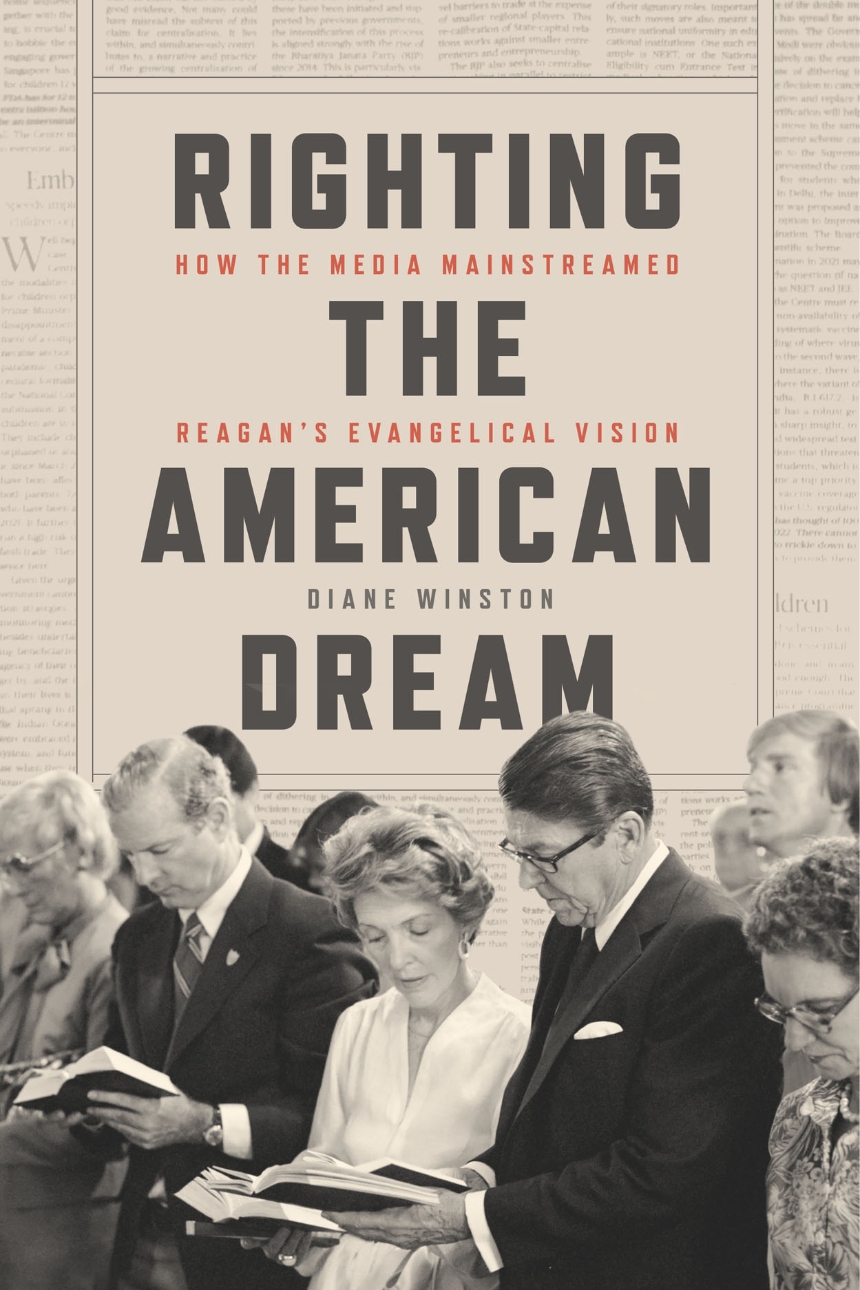Righting the American Dream
How the Media Mainstreamed Reagan’s Evangelical Vision
Righting the American Dream
How the Media Mainstreamed Reagan’s Evangelical Vision
After two years in the White House, an aging and increasingly unpopular Ronald Reagan looked like a one-term president, but in 1983 something changed. Reagan spoke of his embattled agenda as a spiritual rather than a political project and cast his vision for limited government and market economics as the natural outworking of religious conviction. The news media broadcast this message with enthusiasm, and white evangelicals rallied to the president’s cause. With their support, Reagan won reelection and continued to dismantle the welfare state, unraveling a political consensus that stood for half a century.
In Righting the American Dream, Diane Winston reveals how support for Reagan emerged from a new religious vision of American identity circulating in the popular press. Through four key events—the “evil empire” speech, AIDS outbreak, invasion of Grenada, and rise in American poverty rates—Winston shows that many journalists uncritically adopted Reagan’s religious rhetoric and ultimately mainstreamed otherwise unpopular evangelical ideas about individual responsibility. The result is a provocative new account of how Reagan together with the press turned America to the right and initiated a social revolution that continues today.
256 pages | 26 halftones | 6 x 9 | © 2023
History: American History
Political Science: American Government and Politics
Religion: American Religions, Christianity
Reviews
Table of Contents
Part One. Context: Media, Politics, and Religion
1. Faith in the Media
2. 1973: The Body Politic and the Religious Body
3. An American Religious Imaginary
Part Two. Reporting Reagan’s Imaginary
4. Evil Empires: Communism and AIDS
5. The “New Patriotism”: The Mission in Grenada
6. Scrooged: Moralizing Welfare and Racializing Poverty
Epilogue
Acknowledgments
Notes
Index
Excerpt
In January 1983, President Ronald Reagan faced an unhappy electorate. By midmonth, his job approval rating would fall to 35 percent— an all- time low. His proposals to cut income taxes and social spending while tightening the money supply and increasing the military budget did not produce the positive results he had predicted. In 1982, the unemployment rate hovered at 10.4 percent and the real gross national product had fallen almost 2.5 percent, the largest drop- off of the postwar era. Housing starts were at their lowest since 1946, while mortgage rates rose to over 16 percent. In fact, the economy was so bad and Reagan’s image so tarnished that the president’s advisors were desperate for their boss to provide a compelling case for his continued leadership. Even conservative Christians, his strongest supporters, were disgruntled by a lack of concrete change: abortion remained legal while school prayer was against the law.
But if Reagan was worried, he didn’t let the public know. Rather than admit anything was wrong, he blamed the news media for erroneous reporting.
“I came in to point out to you accurately where the disarray lies,” the president said at a news conference in the White House press room. “It’s in those stories that seem to be going around, because they are not based in fact.”
Many of those stories were based on leaks from administration insiders, whom the president criticized too. But from a distance of decades, the important question is not who leaked the stories or how true they were. Rather, it’s how, in less than a year, a foundering leader turned into America’s white knight. By exploring the political, religious, and media history of the 1980s through news narratives that helped propagate and, in turn, shape the Reagan Revolution, this book provides an answer. It focuses on the pivotal year of 1983, when the economy rallied, America’s global standing rose, and Reagan convinced many conservatives and evangelicals that he was still their man.
Reagan’s ability to set and dominate news media narratives was crucial to his success. And whether discussing international relations, military decisions, or economic policy, he often included a religious or moral dimension in his comments. Critics dismissed his claims of divine justification for secular actions, but their complaints had little impact on the president or his policies. Nor did they stop the recasting of the nation’s culture and ideology. Americans’ understanding of themselves and their world was changing. The religious worldview that accompanied this shift encompassed more than a set of sacred beliefs. It also enfolded economic tenets, social values, and political practices that would shape the United States and its citizens. Reagan knew or intuited this transformation, which mirrored his own ideas about God and country, and made it central to his political platform.
I call that cluster of religious, economic, and political beliefs an American religious imaginary. A commonsense understanding of metaphysical truths, ethical norms, and civic virtues, a religious imaginary draws on traditional religious and/or cultural notions of the common good to provide mission, identity, and purpose for citizens as individuals and as national stakeholders. A national religious imaginary can encompass a belief in the supernatural; but most important, it offers a shared orientation to everyday life, especially political and economic convictions reflecting a higher purpose. Religious imaginaries shape individual identity and social relations, including what people expect of themselves and their world; how they expect others will behave and how they interpret their own daily interactions; and most significantly, what they know to be true, real, and good. In other words, a religious imaginary instills a collective sense of what’s normal— that is, the correct way (whether for religious or for ethical reasons) to live one’s life as both a private individual and a public person. It also provides a way for people to think about national destiny and their role in its fulfillment.
